 |
| I hesitate to describe any RC product using that term, but in the case of the new Spektrum DX7, revolutionary is the perfect word to describe a product that has the potential to fundamentally change the world of RC. Some may think I am being overly dramatic, but I suspect that after reading this article, you just might agree with my take on the Spektrum DX7. In late 2005, Spektrum introduced the RC world to Digital Spectrum Modulation 2.4GHz technology (DSM) for park flyers and electric helicopters with the Spektrum DX6 transmitter and AR6000 DSM receiver (see Fly RC, March 2006). Together they offer the freedom of crystal-free, pin-free, interference-free performance for your small models. With the recent introduction of the DX7 transmitter and AR7000 receiver, Spektrum has made this same technology available to models of any size and speed. Ive had the distinct honor of testing the new Spektrum DX7 in a wide variety of airplanes for the last few months, and the new DSM2 technology has absolutely blown me away during this time. I have flown everything from small park flyers to 35 percent gas giants with this radio, all without a single glitch. The DX7 link |
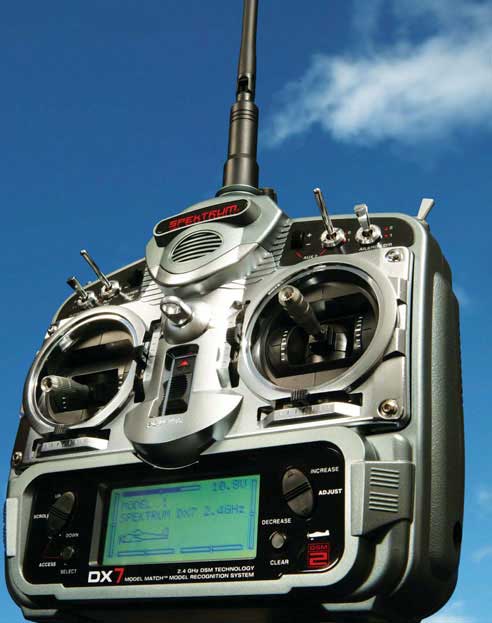 |
|
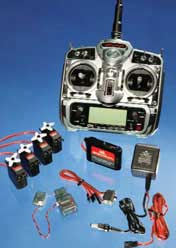
is so solid, it is uncanny. Gone are the inevitable twitches and dropouts we have taken for granted with 72MHz systems. Lets take a look at DSM2 technology, the DX7 transmitter and AR7000 receiver, and how they promise to revolutionize the way you fly model airplanes of every size.
2.4GHZ REFRESHER
What exactly is the big deal with this new 2.4GHz technology? How can it possibly be glitch-free, and how can I just turn on with total disregard for a frequency board? It all begins with the manner in which the 72MHz and 2.4GHZ (2400MHz) bands are regulated. As you are aware, traditional 72MHz systems share the frequency band with many users, and interference is a mere power switch
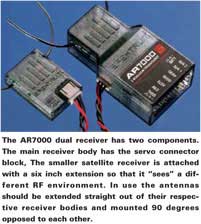
|
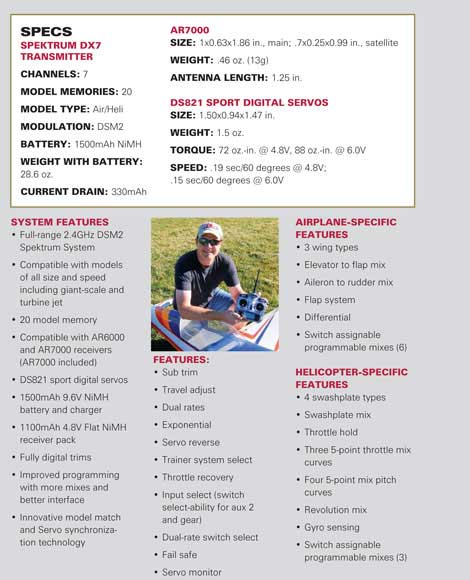
away if another user activates his radio on your frequency. The FCC also allows highpower users to locate in-between the channels dedicated for RC use, which can cause interference. Normally, 72MHz works very well as our receivers are great at weeding through all the noise, but interference, whether man-made or as a result of onboard electronics, does happen.When the FCC and other international bodies got together to come up with the rules for the new 2.4GHz frequencies, they took an entirely different tact. Instead of a frequency free-for-all, they decided to require all 2.4GHz capable devices to interface with each other, ensuring multiple users couldnt occupy the same frequency concurrently. Now, as you turn on your new DX7, it scans all 80 channels in the band, finds two that are free, locks onto them, and begins transmitting. Your transmitter simply cant interfere with other systems, and other transmitters cant interfere with your system. Finally, the DX7 is immune to traditional RF noise caused by ignition systems and onboard electronics because the noise they create is in a completely different frequency range. My experience has proven to me that the DX7 and its DSM2 modulation is the most secure, glitch-free radio system on the market today.
DSM2 MODULATION
Based on the success of the DX6 and its DSM technology, Spektrum incorporated the second- generation DSM2 modulation into the new DX7 system. In addition to significantly |
|
| increasing the range of the system, theyve also increased the systems speed and resolution, dramatically improving signal processing and latency. The result is a radio system that responds to your inputs faster than any 72MHz system on the market.My personal experience mirrors this claim. As a cautious modeler, I slowly ramped up during testing from smaller park flyers to my larger gas-powered models. Each test model was flown back-to-back first with my standard 72MHz system, followed by the DX7 with identical mixing, rates and expo. In each case, the model flown with the DX7/AR7000 combo responded every bit as quickly and precisely as my fastest 72MHz system. From my perspective, variations in system response and latency are emphasized during maneuvers that require highly stick-pattern driven inputs like the rolling harrierand in several cases, my timing had to be accelerated to compensate for the responsiveness of the DX7 system |
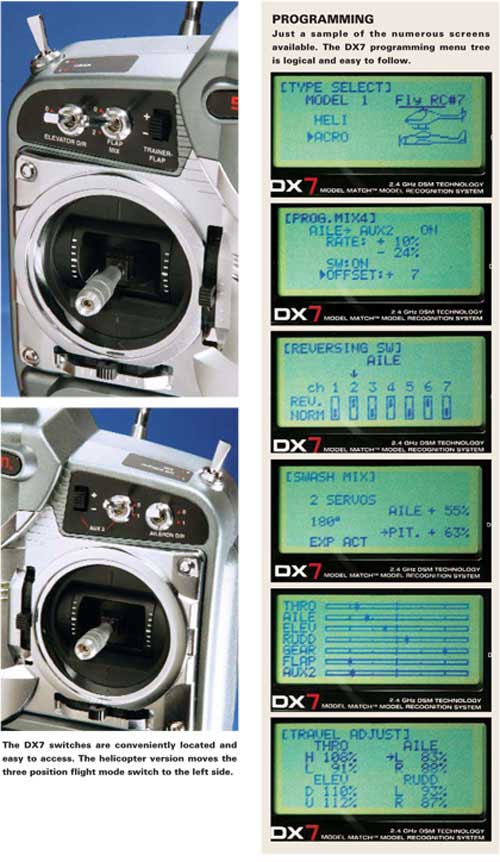 |
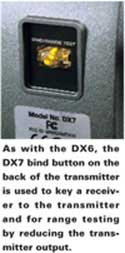 |
Data from both receivers is processed by the AR7000s onboard software, resulting in the clearest RF picture possible. This innovation dramatically improves the systems precision, but more important, it improves its range by allowing it to be used in virtually any size or speed of model. Installing the AR7000, like the AR6000, is very straightforward. Simply mount the primary receiver with foam tape or a foam wrap anywhere in the fuselage, or in the case of a helicopter on the main radio tray. Mount the remote receiver with either foam tape or servo tape at least two inches from the primary receivers antenna array. In a perfect world, each receivers 1.25-inch antenna array would be mounted perpendicular to the other. Ive tried to emulate this ideal, as well as tried much more casual installations, without a noticeable difference in performance. The receiver has slots for up to seven servos, so for airplanes with multiple servos per channel, you can use Y-harnesses, Matchboxes, or an external unit like the Smart-Fly Power Expander. Ive successfully flown the AR7000 many times in my 10-servo, 35 percent Giles powered with a DA-100 gas engine, and Im convinced that the AR7000 is capable of flying any model requiring seven or less channels, even including complex giantscale gas airplanes. |
| TWO SETS OF EYES THE AR7000 DSM2 RECEIVERThe original AR6000 DSM receiver used two integral receivers, each individually and independently tuned to different unique channels to ensure that if one channel lost frames, the second would maintain a secure link between the model and radio. The new AR7000 DSM2 receiver takes that redundancy one step further. The AR7000 has a second remote receiver in addition to the main receiving unit on the receivers PC board. The remote satellite receiver is attached to the main receiver with a six-inch lead.The basic premise is that two eyes are better than one, and when separated by a short distance, the receivers see slightly different RF environments that, when combined, offer a far greater level of precision and accuracy. |
|
INNOVATIVE FEATURESMODEL MATCH AND SERVO SYNC
Weve all done it, but only some of us will admit it. You know exactly what I am talking about. Thats right, taking off with the wrong model selected on our computer radio, of course. Technology to the rescue with the DX7, this event is a thing of the past. For those of you familiar with the DX6, you know that each receiver is bound to an individual transmitter. The process is quick and easy, and is a primary feature of the DSM technology linking the receiver with a specific transmitter identification code, ensuring that the receiver responds to that transmitter alone.
The DX7 takes binding one step further. When binding an AR7000 receiver to your transmitter, the receiver also remembers the specific airplane model you have actively selected on the DX7. That receiver will now only respond to the DX7 when that model is selected and active. With the DX7, it is finally impossible to fly with the wrong model selected in the transmitter. This feature also works with the original AR6000 receivers. In fact, while the AR6000 retains its original restriction for park flyers and small electric helicopters, all of the new features described here also apply to the AR6000 when used with the DX7.
|
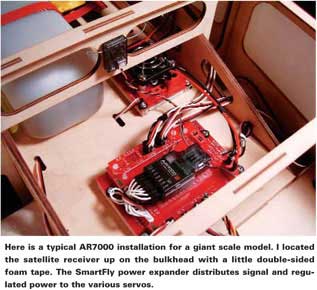 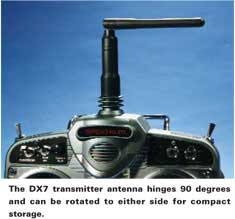 |
|
Servo Sync is the other major innovation incorporated into the DX7. Traditional radios use a very linear transmission methodology, simply running sequentially from channel one through, in this case with a seven-channel transmitter, channel seven. This causes slight delays, depending on the type of mixing used. For instance, on a larger dual elevator servo model, it isnt uncommon to use channel selections that are far apart, for instance, channels two and seven on your receiver. This can result in a perceptible lag between the two surfaces during quick or extreme deflections.
The DX7 eliminates this with a feature called servo sync. Basically, the DX7 looks at the different mixes selected, and re-synchronizes the data so that servos that need to move together actually move together. A good example of this is a 120-degree CCPM three-servo head on a helicopter. The DX7 knows the head type mixing selected, and sends all three head servos the correct data at the same time. The result is as precise a feel as Ive ever experienced in any radio system.
|
|
| DX7 PROGRAMMING SPECIFICSClearly, the most compelling feature of the DX7 system is the fact that it offers the security, speed and precision of spread spectrum technology to models of all sizes, so it might be easy to overlook the fact that the transmitter itself is a really nice, featurepacked mid-level sport radio. So the question begs, how capable is the transmitter? Based largely on the new JR 7202, the Spektrum DX7 offers all of the mixing and programming flexibility that the vast majority of the modeling community could possibly need or reasonably use. As I mentioned earlier, Ive flown the DX7 in a wide variety of airplanes. These have included small park flyers, traditional .60 size club models, and even my 35 percent IMAC aerobat. In each case, I found the DX7 to be a capable radio that was not only easy to program, but also very intuitive to operate.The DX7 is available in two versions: airplane and helicopter. Both share identical programming options, differing only in switch layout, so each can fly helicopters and airplanes equally well. The DX7 includes a 1500mAh pack, allowing up to six hours of operation between recharges, a substantial upgrade over the DX6. The pilot interface is very logical, using a toggle switch and confirmation button along each side of the large LCD display. Like the 7202, there are two basic programming menus: system setup mode and function mode. System setup options include model selection, head type for helicopters, wing type for airplanes, and other administrative functions; function mode options include dual rates, exponential, and both helicopter and airplane appropriate mixing options including three (helicopter) to six (airplane) programmable mixes. For more on the programming capabilities of the DX7, take a look at the December 2006 issue of Fly RC for my review of JR 7202, or review that same article online at www.flyrc.com. Other than broadcasting on different frequency bands, the radios, for all intents and purposes, are the same.Overall, the DX7 offers a very capable radio system that when combined with the AR7000 full-range receiver will meet the needs of the vast majority of modelers, all in a glitch-free and affordable package.CONCLUSIONIn my 23 years of RC modeling, Ive seen technology that claimed to be the next great thing come and go many times over. Some products, however, make their mark in such a way that they completely redefine the market. I would offer that the Spektrum DX7, with its 2.4GHz fullrange DSM2 technology, is such a product. After operating the DX7 for the last few months, Im completely sold on the DX7not one single glitch in well over 150 flights. The confidence of knowing that you cant be shotdown by an errant signal is hard to put a value on. For my peace of mind though, at $349.99, the DX7 is an absolute steal. |
|
| |

